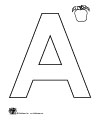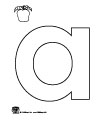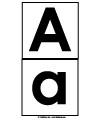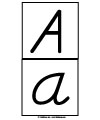Objectives:
Children will explore, form, and learn the shape of the letter A.
Children will learn that the uppercase letter A and lowercase letter a have a distinct shape.
Children will recognize similarities and differences in letters.
Instructions:
Look at the letter poster together with children. Talk about the shape of the letter. How does the letter look? Does it have straight lines, curves, circles, etc. Let children draw the shape of the letter in the air or on the floor with their fingers.
NOTE: Children learn in many different ways. Kinesthetic-tactile children learn best with hands-on and movement activities. The following activities will especially benefit these children.
Provide a varity of tactile materials for children to write, form, and feel the shape of the letter:
Sandpaper letter
Finger paint
Rice or sand on a cookie sheet
Shaving cream
Cold spaghetti (with lots of oil so the noodles don't stick together)
Play dough
Bread or cookie dough
Pipe cleaners
Yarn or ropes
Wikki Stix
Wooden letters
Magnetic letters
Activities:
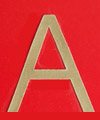
How to Make Sandpaper Letters
Print sandpaper letter printable and cut out. Trace letter shape on to a sheet of sandpaper and cut out. Glue letter shape on to cardstock paper.
Variation: Add glue to the top of the letter and sprinkle sand on the glue while still wet. Shake off excess sand.
Let children trace the sandpaper letter with their finger and say the name of the letter.
Extension:
Tape sandpaper letter on to table. Place a sheet of copy paper on top of the sandpaper letter and let children use crayons to make letter rubbings. sergio
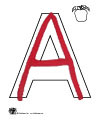
Form the Letter
Print uppercase- or lowercase-letter printables on heavy printing paper. To use as a letter place mat, laminate the letter for extra strength.
Let children use play dough, bread, or cookie dough to form the letter on the letter place mat.
Variations:
Let children glue pasta, rice, sand, or any other material on to the letter shape to make a tactile letter. Glue on to cardstock paper.







